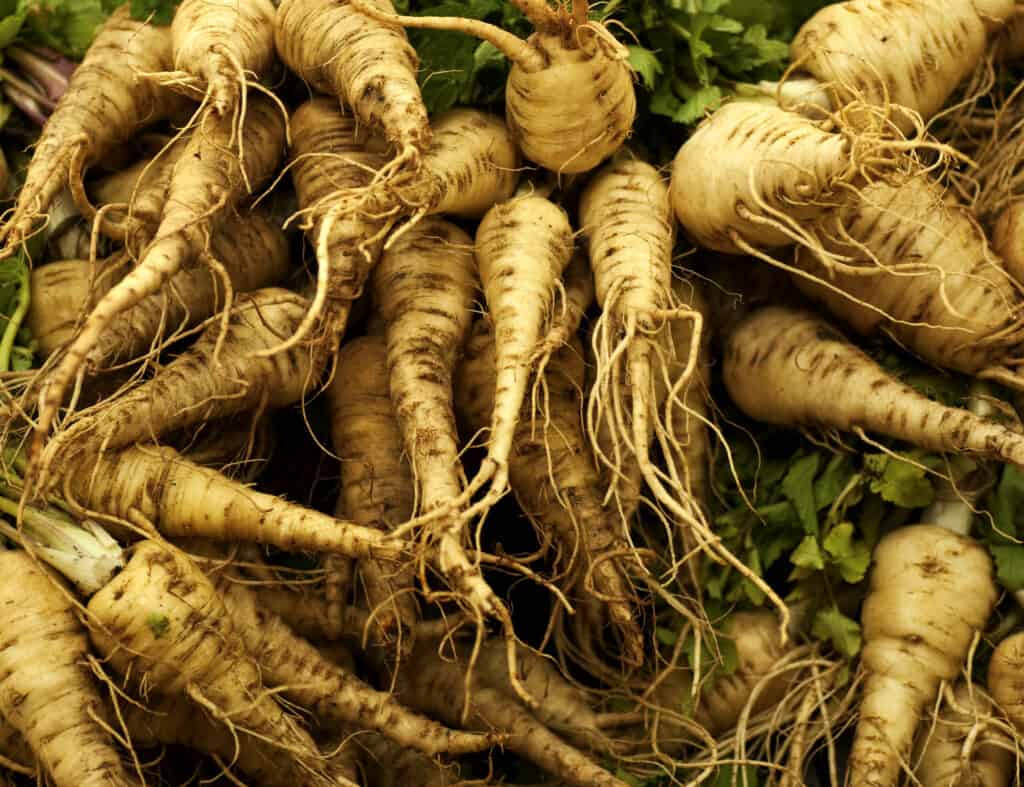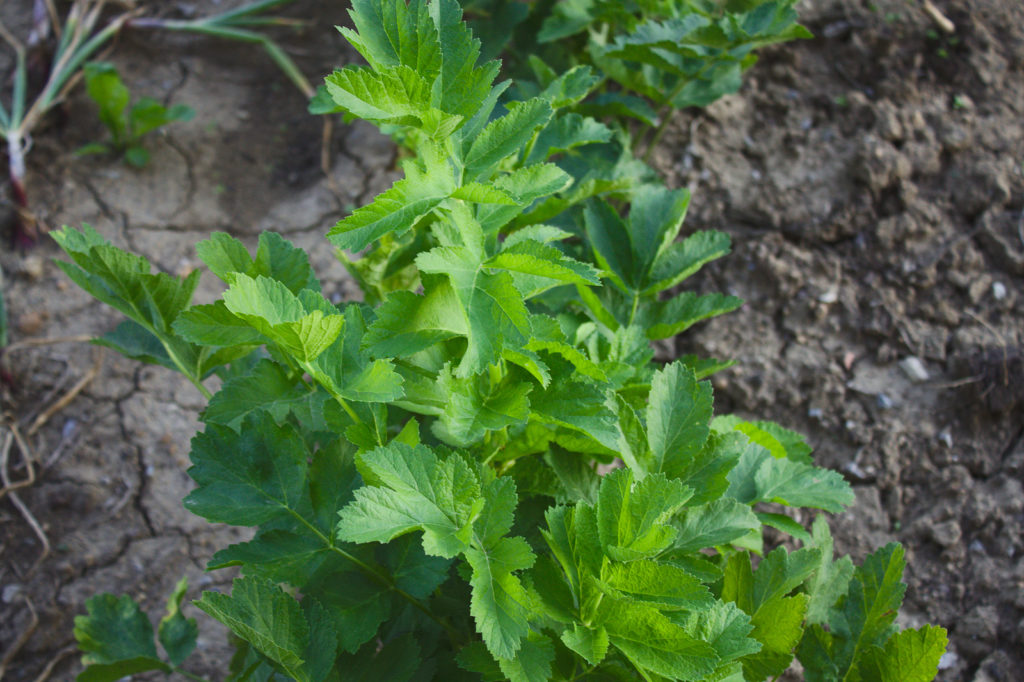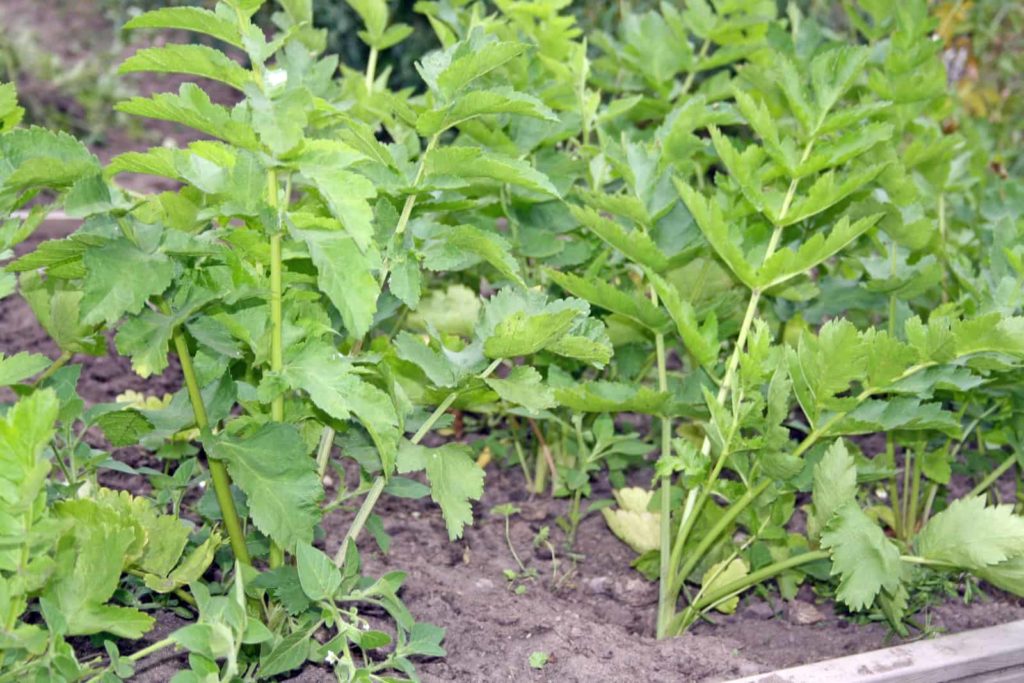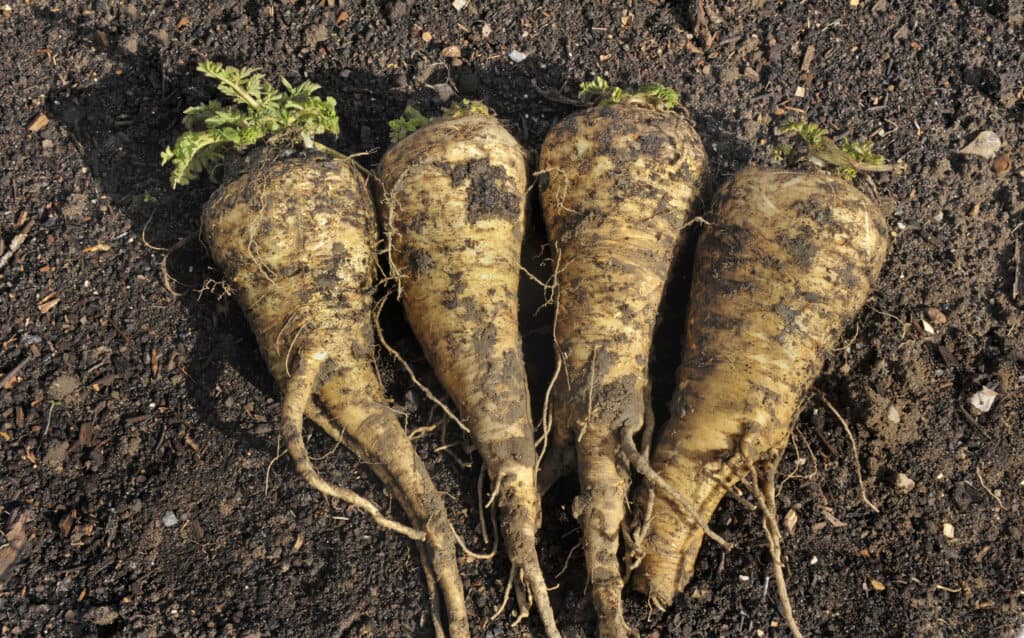Parsnips are cool-weather biennials grown as an annual. Parsnips taste best if brought to harvest in cool weather. The parsnip is a creamy white root that grows from 4 to 9 inches (10-22cm) long, similar to a carrot in appearance and tasty like a celery heart. The parsnip is a biennial grown as an annual. A rosette of celery-like leaves grows from the top of the fleshy root.
The parsnip is a root crop that can be planted in spring and autumn in all regions and in winter in mild-winter regions. Parsnips require 95 to 120 days to mature and reach harvest. The parsnip root is most tasty after it has come through freezing temperatures.
Related articles:
- Five Quick Ways to Cook and Serve Parsnips
- Parsnips Seed Starting Tips
- How to Harvest and Store Parsnips
- Parsnip Growing Problems Troubleshooting
- How to Plant and Grow Parsnips

Here’s your complete guide to growing parsnips.
Parsnips quick growing tips
- Sow parsnip seed directly in the garden 2 to 3 weeks before the average date of the last frost in spring. In warm-winter regions, parsnips can be planted in autumn.
- Plant 10 parsnips per household member.
Tools for Vegetable Gardeners at Amazon:
- A.M. Leonard Straight Rake with Ash Handle
- All-Steel Nursery Spade with D-Grip Handle
- 4-Tine Spading Digging Fork with D-Handle
- Digital Soil pH Meter Outdoors Greenhouse
- Earthwise Handheld Electric Fertilizer Spreader
When to plant parsnips
Parsnips require as many as 120 days to reach maturity and harvest. Freezing weather makes parsnips taste sweeter as the root’s starch converts to sugar. Sow parsnip seeds in spring for autumn harvest; sow seeds 2-4 weeks before the last expected frost to 4 weeks after the last frost. In mild-winter regions sow in early summer for a winter harvest or in autumn for a spring harvest.
- Parsnips require a long, cool growing season where the average temperature is between 45°F and 65°F (7-18°C).
- Parsnips will tolerate cold and freezing temperatures at both the start and end of their growing time.
- Sow parsnip seed directly in the garden 2 to 3 weeks before the average date of the last frost in spring. In warm-winter regions, parsnips can be planted in autumn.
Spring planting. Sow parsnips 2 to 3 weeks before the average date of the last frost in spring as soon as the soil can be worked. Germination is slow in temperatures below 45°F (12°C). Spring-planted parsnips will come to harvest after the first frost in autumn or leave the crop in the ground until needed. In cold regions, sow parsnips in mid-spring.
Autumn and winter planting. Sow parsnips in autumn or winter in warm-winter regions. These plants will mature more slowly and will likely come to harvest the following autumn or winter. (Tips on planting the autumn garden, click here.)

Where to plant parsnips
Parsnips prefer full sun but will grow in partial shade. Parsnips require more than three months to reach harvest; interplant faster-maturing crops such as lettuce and spinach between parsnips.
Parsnips grow best in rich, well-drained soil. Deeply work the soil to at least 12 inches (30 cm) removing any rocks, dirt clods, or roots from the planting bed which will cause parsnip roots to split and fork. Add garden compost and well-aged manure into the planting bed. Fresh manure can also cause parsnip roots to fork. Parsnips grow best in soil with a pH of about 6.5; if the soil is more acidic add lime. In hard or stony soil, use a crowbar or dibbler to make holes 6 inches deep; fill the holes with good soil and sow 2 to 3 parsnip seeds.
- Parsnips prefer full sun but will tolerate partial shade.
- Grow parsnips in soil that has been turned to 12 inches (30cm) deep where all lumps and rocks have been removed so that roots do not split and fork.
- Parsnip prefers a soil pH of 6.0 to 6.8.
- Prepare planting beds two to three months in advance adding well-aged compost. Add manure only if it is aged; manure too fresh will cause root crops to fork.
Planting and spacing parsnips
Sow parsnip seed ½ to 1 inch deep. To improve germination, soak the seeds in water for a day before planting. Soak the seed in warm water for 8 hours to increase germination. Thin parsnip seedlings to 6 inches (15 cm) apart in wide beds or blocks. Space rows 12 to 18 inches apart. Thinning will allow for full root development of the remaining plants; cut seedlings off at ground level to avoid disturbing the remaining seedlings.
- Sow parsnip seeds ½ inch deep and 1 inch (2.5cm) apart in wide rows; thin seedlings to 3 to 4 inches (7-25cm) apart.
- Space rows 18 to 24 inches (45-61cm) apart.
- Thin seedlings after they develop two true leaves; cut off thinned seedlings at soil level to avoid disturbing remaining seedlings. Thinning is important; parsnips require adequate space for root development.
Parsnip companion plants
- Good companion plants for parsnips include beets, carrots, rutabagas, and root vegetables.
- Avoid planting with cabbage family crops, tomatoes, and tomatillos.
Container growing parsnips
Parsnips require adequate space for root growth; they are not a good choice for container growth.
- Parsnips can be grown in containers but require at least 18 inches (45cm) of root space.

Growing parsnips
Thin successful plants to 3 to 4 inches (7.5-10 cm) apart in all directions. Keep the soil evenly moist during the early stages of root growth to prevent the roots from splitting. Carefully work well-rotted compost or manure around plants 4 to 6 weeks after seedlings emerge. Side-dress plants with fish emulsion once a month during the growing season. In severe winter climates protect unharvested roots from freezing over the winter with 6 to 10 inches (15-25 cm) of straw.
Watering parsnips
Keep the soil around parsnips moist but not wet. Reduce watering as parsnips approach harvest; too much moisture late in their season will cause the roots to crack. Mulch parsnips to keep the soil cool in hot weather; mulch heavily to protect parsnips if the ground is likely to freeze in winter.
- Parsnips require moist but not wet soil for uninterrupted root development.
- As roots approach maturity, reduce watering to avoid cracking.
Feeding parsnips
Add plenty of compost to the planting bed before sowing. Add compost to the garden at midseason as well.
- Prepare planting beds with aged compost. Add aged manure to planting beds in advance of planting.
- Side dress plants at midseason with aged compost.
Parsnips care
- Keep planting beds weed-free to avoid competition for light, water, and nutrients. Cultivate shallowly to avoid damaging roots.
- Where the ground may freeze, add 6 to 10 inches (15-25cm) of straw or mulch above plants before the first snow; harvest roots as needed in winter.
- In warm regions, mulch regulates soil temperature; roots will grow short if the soil temperature is too high.
Parsnips pests and diseases
- Parsnips are generally not bothered by pests.
- Root maggots may be troublesome; discourage flies from laying eggs near the plants by putting a 3 to 4-inch (7-10cm) square of plastic around each plant.
- Parsnips have no serious disease problems.

Harvesting and storing parsnips
Parsnips will be ready for harvest 95-100 days after sowing. The sweetest roots are lifted after heavy frosts in late autumn. Complete your harvest by early spring before top growth begins again. Roots left in the ground all winter will have the best flavor, and sugar content increases with cold weather. Do not leave roots in the ground for a second season as they will become too fibrous to eat.
- Parsnips reach maturity 100 to 130 days after sowing.
- Lift parsnips with a spading fork being careful not to damage roots.
- Roots can stay in the garden through the winter if the ground does not freeze. Cold temperatures will increase the sweetness of roots.
- Dig roots before the ground freezes and becomes unworkable.
- Complete the harvest before the return of warm weather or roots will become pithy.
Storing and preserving parsnips
- Store parsnips in the refrigerator for up to 2 months or in a cold, moist place for 2 to 6 months.
Parsnip varieties to grow
Parsnips varieties: ‘All American’ (105 days); ‘Cobham Improved Marrow’ (120 days); ‘Gladiator’ (110 days); ‘Harris Early Model’ (100-120 days); ‘Hollow Crown Improved’ (95-135 days); ‘Lancer’ (120 days); ‘Student’ (110 days); ‘Tender and True’ (102 days).
About parsnips
- Common name. Parsnip
- Botanical name. Pastinaca sativa
- Origin. Europe
Parsnip articles at Harvest to Table:
How to Harvest and Store Parsnips
Five Quick Ways to Cook and Serve Parsnips
Carrot and Parsnip Growing Problems Troubleshooting
Garden Planning Books at Amazon:
- Vegetable Garden Grower’s Guide
- Tomato Grower’s Answer Book
- Vegetable Garden Almanac & Planner
- Kitchen Garden Grower’s Guide Vegetable Encyclopedia
Grow 80 vegetables and herbs: KITCHEN GARDEN GROWERS’ GUIDE
More how to grow articles:
Learn how to plant, grow, and harvest your favorite vegetables. Click below for all you need to know.
- Artichoke
- Arugula
- Asparagus
- Beans, Snap
- Beets
- Broad Beans
- Broccoli
- Brussels Sprouts
- Cabbage
- Cantaloupe — Melons
- Cardoon
- Carrots
- Cauliflower
- Celeriac
- Celery
- Chard
- Chayote Squash
- Chickpeas
- Chicory
- Chinese Cabbage
- Collards
- Corn Salad
- Corn, Sweet
- Cresses
- Cucumbers
- Eggplant
- Endive and Escarole
- Fava Beans
- Florence Fennel
- Garbanzo Beans
- Garlic
- Horseradish
- Jerusalem Artichoke
- Kale
- Kohlrabi
- Leeks
- Lettuce
- Lima Beans
- Melons
- Mizuna
- Mustard Greens
- New Zealand Spinach
- Okra
- Onions
- Parsnips
- Peanuts
- Peas
- Peppers
- Potatoes
- Pumpkins
- Radicchio
- Radishes
- Rhubarb
- Rutabaga
- Salsify
- Shallots
- Sorrel
- Southern Peas
- Soybeans
- Spinach
- Squash, Summer
- Squash, Winter
- Sunchokes
- Sweet Potato
- Swiss Chard
- Taro
- Tomatillo
- Tomatoes
- Turnips
- Watermelon
- Zucchini















